By SCOTT MCKIE B.P.
ONE FEATHER STAFF
Local students are in their second week of home learning following statewide and tribal-wide school closures due to the spread of the coronavirus (COVID-19). Many of those students, and their families, are facing challenges with a new learning environment.
Following an executive order on Friday, March 14, by N.C. Governor Roy Cooper, that closed state public schools until the end of March, Cherokee Central Schools (CCS) followed suit. Gov. Cooper extended those closures, in another executive order on Monday, March 23, to at least May 15 as did CCS.
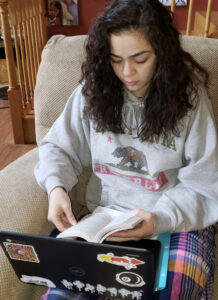
Tsini McCoy, an EBCI tribal member and freshman at Swain County High School, works on assignments. (Photo courtesy of McCoy family)
“The motivation that being in a live classroom provides is definitely lacking at home,” said Rosie McCoy, a mother of two students from the Birdtown Community. “They feel like they can put it off longer.”
She added, “They both have a better appreciation for school. Neither one ever expected they would miss school like this, so it has been an eye-opening experience. Not only do they miss their social life at school, but they miss the whole ‘at-school’ experience.”
Connor McCoy, 18, Rosie’s son and a member of the Eastern Band of Cherokee Indians (EBCI), is a senior at Swain County High School. “This whole thing has made me really uneasy. It’s hard to find motivation to do things regarding schoolwork. I also miss my teachers and friends.”
Tsini McCoy, 15, Rosie’s daughter, is an EBCI tribal member and a freshman at Swain County. “I don’t like being stuck at home because I like seeing my friends every day. I am a very social person and this is hard for me.”
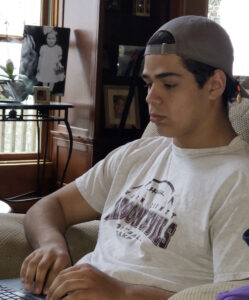
Connor McCoy, an EBCI tribal member and senior at Swain County High School, works on his laptop at home. (Photo courtesy of McCoy family)
Being at home is causing Connor to miss many of the things associated with being a senior in high school. “This experience has made my senior year not so great. I can’t see my teachers and friends, and I can’t do my senior sports. I won’t get to have senior prom and may not be able to walk for graduation. So, this has pretty much ruined my senior year. I’m just trying to understand the issue and do what I’m supposed to do to stay safe.”
Michelle Long, an EBCI tribal member from the Big Cove Community, is a lead teacher at New Kituwah Academy which is also closed for the time being. At home, she is working with two students – her son Denili Hill, 14, who is in the ninth grade at Cherokee High School, and Layla E.R. Johnson, 14, who is in the eighth grade at Cherokee Middle School.
“Math has changed so much,” said Michelle. “If they have questions, I just tell them to do what they can. Internet and Wi-Fi is an issue.”
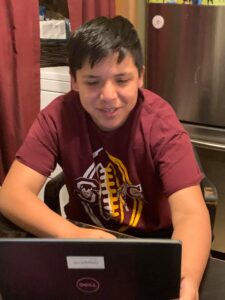
Denili Hill, an EBCI tribal member and freshman at Cherokee High School, works on school assignments on his laptop. (Photo courtesy of Long family)
She said there has been some positives to the situation though including increased family time. “My kids are learning a lot more of the cultural ways. They have enjoyed the outdoors more! They have been fishing. They have gathered ramps and started a garden. Today, they will learn how to prepare river cane, and Denili will be helping his dad make stickball sticks. They have been helping prepare meals, they cook!”
Denili, an EBCI tribal member, noted, “It’s better than being at school. I’m having a lot of fun moments. I’m getting a lot more exercise.”
Layla, a member of the Santee Sioux Tribe of Nebraska, said, “It’s boring because I don’t have my friends.”
Dr. Debora Foerst, Cherokee High School (CHS) principal, spoke to the One Feather on the school’s plan during the closure. “Cherokee High School is engaged in a hybrid approach. We are a 1:1 school, as in each of our students is given a laptop for educational use; however, not all students have internet access at home. So, teachers have prepared print packets, uploaded items into a shared folder that students were encouraged to access before they left campus on Friday, March 13, and/or are using Google Classroom.”
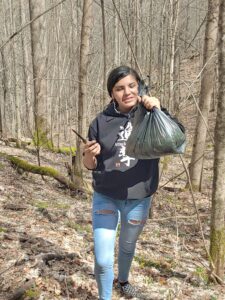
Layla Johnson, a member of the Santee Sioux Tribe of Nebraska and an eighth grader at Cherokee Middle School, is shown collecting ramps as part of outdoor education while schools are closed. (Photo courtesy of Long family)
She went on to say, “Students who need internet access can use the Wi-Fi that our CCS IT staff has pushed into the parking lot in front of CHS, and Cherokee Broadband has made free Wi-Fi available in a variety of places throughout town. Students can stay in their cars, maintain social distancing, and access the internet to complete their work.”
Dr. Foerst said there have been challenges to this new environment. “The fact that not all students have internet access has been a big challenge. Additionally, it was challenging for teachers to create or produce material in such a short time frame that would support student learning over an extended period of time. Finally, making sure we have an accountability piece in place for the work we are sending home has been a challenge. We want students and parents to take this work seriously, so completing it will be beneficial, and not completing it will produce consequences.”
In addition to being the principal of Cherokee High School, Dr. Foerst is also the mother of a CHS student. “My daughter is a good student who is conscientious about her assignments. As a matter of fact, the second the school closure was announced, she grabbed her packets and got to work. So, the school work has not been an issue. The biggest challenge, as a parent, is the fact that my daughter is super active and super social and both of those avenues have been shifted or shut down completely.”
She added, “Her high school track season, her travel volleyball season, and her work in the CHS musical ‘Hairspray’, all came to an immediate halt, not to mention that she and her friends have been unable to get together, go bowling, or go to the movies. I’ve tried to step up my activity level though. So, we have gone out walking, built evening fires in the backyard, and we’ve grown quite competitive in Phase 10.”
Ethan Clapsaddle is helping four students, in three different educational institutions, with their work including his son, Goo Clapsaddle, 11, an EBCI tribal member who is a sixth grader at Cherokee Middle School; his son, Walker Clapsaddle, 15, an EBCI tribal member who is a freshman at Rabun Gap-Nacoochee School; Johannes Solibieda, 15, a sophomore exchange student from Germany who attends Rabun Gap with Walker; and Nolan Arkansas, 20, an EBCI tribal member who is a sophomore at Yale University who comes to their house several times a week to utilize their internet access to finish his spring semester online following the closure of in-person instruction at the university.
“Some of the challenges we are facing are on a couple of different fronts,” Ethan said. “For the older boys, they were with us for their spring break prior to the outbreak restrictions so they don’t have their computers, books, materials, etc. We can’t get back on campus to get these things so we are simply trying to make do. We have limited computers here at home. So, we are having to rotate and share Wi-Fi, tablets, and a laptop between the kids and my needs for work and the doctoral program I am in at Western Carolina University.”
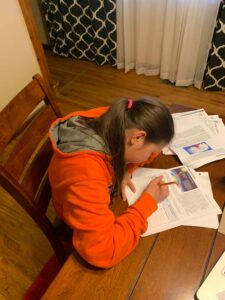
Haizleigh Driver, an EBCI tribal member and student at New Kituwah Academy, completes worksheets from her school print packet. (Photo courtesy of Driver family)
He goes on to state, “I guess beyond the logistical issues is just the frustrations of the whole doing schoolwork from home for all of these guys. I know these are unprecedented times for everyone, including the schools. We are in that space between ‘are the kids going back this school year’ or ‘how do we get instruction and course content to them’ at home in a beneficial way?”
Goo said, “I won’t lie, I don’t really like the work packets, but all of this has actually made me miss school. I miss my friends, my teachers, and being able to practice basketball.”
Ethan does see some positives to the situation as well. “The positives for us have been just being able to spend so much time together as a family. Our schedules are always so crazy with work, school, and basketball that we never get to just spend time together. We have eaten family dinners at home more in the last few weeks than we have in a really long time which has been nice. We have gotten to do more outside things together like hikes, playing around the house, and just relaxing together and reconnecting. I haven’t minded that part of all of this at all.”
Dr. Foerst has also seen some positives come out of this situation. “As scary and unsettled as things have seemed for all of us, there are definitely some positives with everyone spending more time at home. I see families spending time with one another, and more folks seem to be hitting the trails and the ramp patches! Students are learning things from their parents, grandparents, and other family members that we can not always teach them here.”
Kristin Driver, a teacher at New Kituwah Academy, has three school-age students at home including a second grader, a third grader, and a fifth grader. “The greatest challenge we have faced, as far as homeschool instruction goes, has been finding a routine/schedule that works for everyone and meets all the academic, social, and emotional needs for each child.”
In addition to the other parents, she has seen positive outcomes. “There are multiple positives to the kids learning from home – more family time, time to teach age-appropriate life skills, more outdoor learning (in our back yard of course), and more flexibility.”
Dr. Foerst summed up the sentiment of many, “People are cooking at home, and we are all realizing that busy is not always better.”





